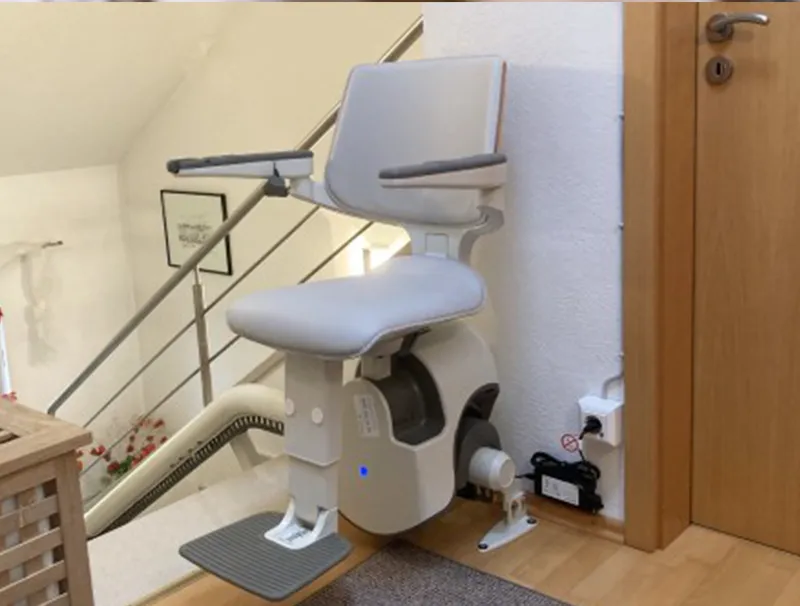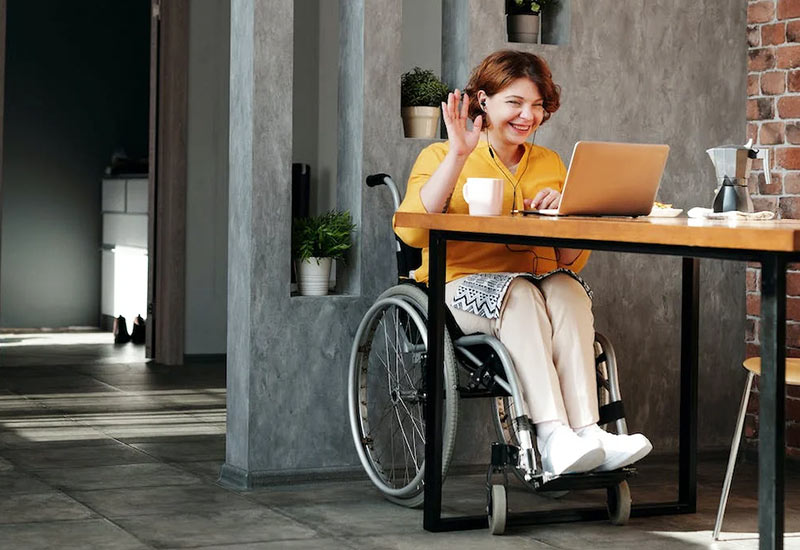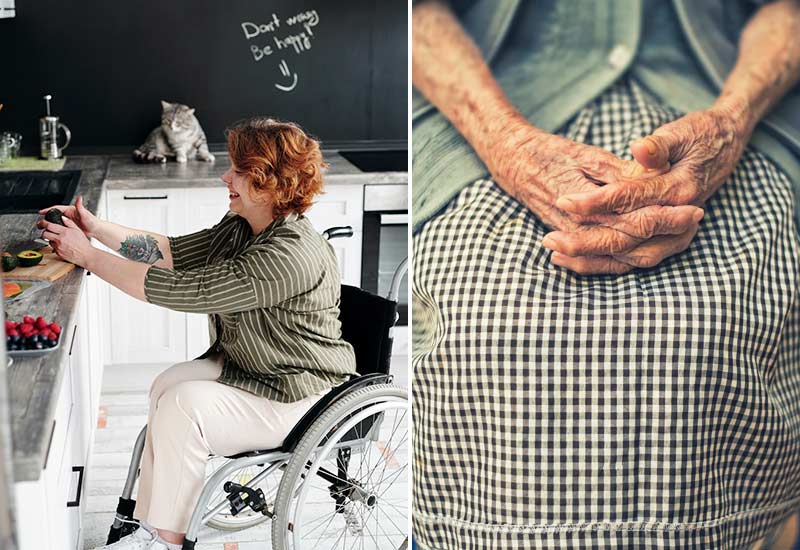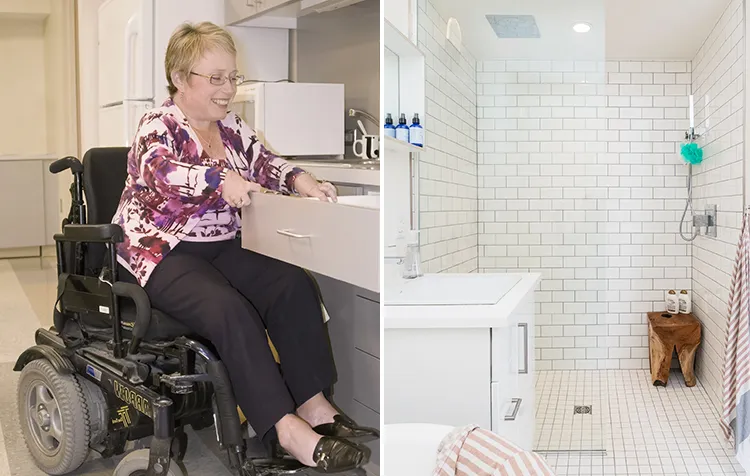You want to live as barrier-free as possible or make someone else's home more age- and disability-friendly? Then you've come to the right place! Accessible living is the wonderful concept of designing a living space so that it is as accessible as possible for people of all ages and physical abilities to use independently.
In our aging society, of course, the idea is becoming increasingly important. It's about inclusion, comfort, safety and a self-determined life - for everyone. But unfortunately, even a dropped cereal bowl or an unreachable shelf can become a real hurdle in a person's everyday life.
Whether you're planning a home from scratch, adapting existing spaces, or just looking for some inspiring advice, there really are plenty of steps you can take to create a home without barriers!
In this article I would like to give you the best tips for barrier-free living. I have divided them for you into concrete new construction and remodeling measures, as well as smaller, subsequent changes that make your apartment or house more age- or disability-friendly. Let's go!
10 tips for remodeling or planning an accessible home

Sooner or later, everyone will have to come to grips with the concept of barrier-free living - whether for their own Parents and grandparents, after a Accident with physical consequences or simply because of it, because you get older yourself. After all, experience has shown that people's own abilities diminish over the course of their lives, making it increasingly difficult to cope with everyday life.
Before we get straight to the simple retrofitting measures that can be implemented quickly and often with little effort, let's first focus on the Tips for new construction or conversionwhich are very difficult to retrofit later or only at considerable cost.
Good to know: The sooner you start thinking about barrier-free living, the better. This will make your home safer and more comfortable - and provide for old age or unforeseeable physical limitations. Last but not least, your property will be even more interesting for potential buyers in the future, should you ever want to sell it.
1. ensure threshold-free transitions
Any step or difference in floor level, no matter how small, can make everyday life more difficult for those with physical limitations. Therefore, prevent tripping hazards and facilitate constant movement between rooms of a house or apartment simply in advance when planning your (preferably ground-level) home. In this way, you make it easier for people with walking aids and Making life easier for wheelchair users, safer and more independent.
2. install sockets, switches and cabinets at reach height.
If you want to make accessible everyday life easier, then you should quietly put sockets on a Height from 60-70 centimeters plan. Installation at reach height avoids unnecessary bending or stretching movements and facilitates access for everyday household chores.
The situation is similar for light switches, which are usually located at 105 centimeters, but in barrier-free households optimally at a height of 85 centimeters should be located.
Also Cabinets in the kitchen, bathroom or utility room should be planned low enough so that they can be easily reached by people in wheelchairs or with other physical limitations.
3. install lift on the stair wall
Even multi-story houses and apartments with stairs can be built or converted barrier-free. An electric elevator or a customized Stairlift can provide people with reduced mobility with a safe and Provide easy access to all floors - and thus significantly increase the quality of life in one's own home.
4. plan rooms with sufficient movement area
A lift, a threshold-free floor and a few height-adjusted sockets do not yet guarantee absolute accessibility in one's own home. In general, the Rooms also wider and especially not too angled The design of the building must be such that there is always enough space for wheelchair users and people with other disabilities to turn around and move around freely.
5. install height adjustable work surface in the kitchen.
Fortunately, there are now height-adjustable work surfaces for the kitchen. They enable all residents to cook and work comfortably. Regardless of their height or mobility - and the help of other people.
Since new kitchens in general - and retrofitting them - can be very expensive, it's best to let this helpful feature already take into account in the construction or planning phase.
6. plan level shower
You can also prevent dangerous tripping hazards with a floor-level shower. You facilitates the entry and exit of elderly or disabled people and make their everyday life a little bit freer.
7. plan wider doors for wheelchair users:inside
Accessibility is not just about having plenty of space in rooms, but also when you enter them. Wide doors are really essential for an accessible home, as they provide a smooth passage for wheelchair users and people with walking aids.
Good to know: Within apartments, a width of 80 centimeters is generally referred to as "barrier-free". At 90 centimeters, the access is considered "usable for wheelchair users".
8. select non-slip floor coverings
Non-slip floors are a simple but effective measure to Prevent accidents at home. This is especially true in areas that experience shows are often damp, wet and therefore slippery - i.e. in the bathroom and kitchen.
Provide high slip resistance Wooden floors or tiles of classes R 12 and R 13They have a high "static friction coefficient". You should always use this value as a guide when making your selection if you want to promote handicapped and age-friendly living.
9. build wide paths and ramps instead of steps
Not only in the house, but also in front of it, you can implement appropriate measures for inclusion. Paved wheelchair ramps in the entrance area, for example, offer a handicapped accessible Alternative to the entrance stairs and are generally considered a central element of barrier-free living.
Also wide accesses from the fence gate to the front door clear any obstacles out of the wayso that even frail or disabled people can get to and from the house without any worries.
10. take advantage of subsidies for barrier-free living.
Of course, the state also offers financial support for adaptations in the house, which you should definitely use to create a barrier-free environment.
For example, you get from the Reconstruction Loan Corporation low-interest loans and grants for age-appropriate conversions to reduce barriers. Also the Health insurance and long-term care insurance usually assume large parts of the costs (from certain degrees of care) - whether for conversion measures or aids.
So, take advantage of the government incentives to Increase quality of life in everyday life and combine it best with the Cooperation with nursing consultants and building surveyors, who are very familiar with the construction and conversion measures for barrier-free living.
10 tips and simple retrofitting with great effect for barrier-free living

Of course, not everyone has the opportunity, Remodel or renovate an existing home from the ground up. For example, because the financial scope is lacking or the landlords do not allow any structural changes. Fortunately, many barriers at home can be minimized with well-considered and cost-effective solutions.
So now I would like to present you with more tips for uncomplicated adaptations that will make everyday life easier for disabled people and people in old age. with little effort much more pleasant and make it safer.
11. install glass shelves in wall units
Conventional shelves in built-in cabinets are not transparent, so that you can, for example sitting from the wheelchair not recognize can what is inside.
By replacing them with glass shelves, the contents can be seen very well even from lower perspectives. And if the upper cabinets are still difficult to reach, it also helps to have such a Gripper for seniors and people with disabilities*. in grabbing the right items.
12. get stool for the shower
A shower at ground level is a good start to true accessibility. But a seat, such as a simple, non-slip shower stool, also provides people with physical disabilities with a seat while showering. Security, independence and last but not least relaxation.
Tip: Making another person's daily life easier with a sit-down stool is a great and thoughtful gesture. Why such good deeds also make ourselves so happyI have examined in more detail in the linked blog article. Feel free to take a look!
13. use anti-slip mats in bathtubs and showers.
Due to the wetness, the floor in showers usually poses the risk of slipping and causing nasty injuries. Fortunately, non-slip mats are an aid to greater accessibility and safety that can be is easy to retrofit and effectively prevent dangerous falls can. Suction cups on the back ensure a secure hold on smoother surfaces.
14. upgrade to wireless technology
Technical aids additionally promote living without obstacles. With wireless devices (e.g. cordless phone) and wireless technology (e.g. W-LAN), for example, the risk of tripping can be further reduced. Maneuvering in the home also becomes easier - especially for people with mobility impairments.
Tip: Smart home technologies and voice-controlled devices also help people with disabilities and in old age to manage their lives more independently. They can be used, for example, to switch lights on and off even more conveniently.
15. place daily used things at handle height
The simple Reorganize of frequently used objects at handle height can make everyday life much easier for people with physical disabilities and promote independence.
For example, it is advisable Crockery and cutlery, pots and pans, salt and pepper, tea and coffee - as well as other utensils and foodstuffs used on a daily basis - should always be kept within easy reach.
16. set up motion sensors for light
Finding the light switch in the darkThis is often a real challenge, especially for seniors and people with physical disabilities.
With the help of technical sensors, the Switch on light also automaticallyas soon as movement is detected. This not only makes everyday life easier (e.g. when going to the toilet at night), but is also extremely environmentally friendly and sustainable. Finally, the light is turned on only when needed. When it is not needed, it goes off automatically, so that Energy saved will.
17. install grab bars in the bathroom
Also grab bars for elderly and disabled people function with suction cups and eliminate the need for costly drilling measures. They provide support and safety in potentially slippery areas such as the bathroom and are a simple and effective step towards barrier-free living.
Tip: Longer handrails can also be easily retrofitted. Of course, they are also a wonderful help in everyday life of elderly or disabled people.
18. remove carpets
Here I have now times a tip for you, which costs absolutely nothing! Carpets represent especially for people with walking aids a constant risk of tripping and, depending on the thickness, can also be problematic for wheelchair users.
Safety always comes before looks. So if you have a non-slip flooring, you can easily remove your flokati and sell it, for example.
19. bridge steps by ramp
Conversion measures can be really expensive. As a cost-effective alternative for bridging entrance steps or thresholds serves for example such a wheelchair ramp* with non-slip surface.
It is really an ideal tool for barrier-free living. But not only that! She can even be taken alongIt can also serve you well outside the home and make your life more age- and wheelchair-friendly.
20. integrate light bell for hearing impaired people
A light bell visualizes acoustic signalssuch as the smoke detector or the doorbell and telephone. This retrofittable (possibly life-saving) measure means that people with hearing impairment are less likely to miss important notifications.
Tip: The light bell also works with smart home systems and can help not only the elderly and disabled, but also general professionals in the home office or parents with small children.
Simply barrier-free living - with disabilities and in old age

A barrier-free home not only makes life easier for people with physical disabili more independent, flexible and betterbut is also an investment in the future.
The decision for accessibility is thereby not only an act of caring for oneself or loved onesbut a respectful sign of foresight and understanding for all people in our society.
And they need not be complicated or expensive. Often, it really is the changes or tools that are inconspicuous at first glance that mean the world to another person.
"Obstacles and difficulties are steps on which we climb up to the heights."
Friedrich Nietzsche (more at Challenge quotes)
I sincerely hope that the tips in this post will help you remove barriers in your home or prevent them from happening in the first place. Do you have any questions, suggestions or your own experiences with accessibility that you would like to share? Then I look forward to your comments.
Stay forward-thinking and helpful,

PS: You love it, Help people? That's a great character trait! If you like, you can now learn what else you can do for the people around you in the linked blog article.







Thank you for the informative post. My great aunt has decided that she would like to move into a senior residence soon. She is excited about the potential greater wellness offerings and a certain level of comfort is very important to her. We are already assisting her in her search.
Comments are closed.